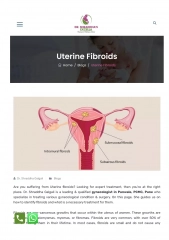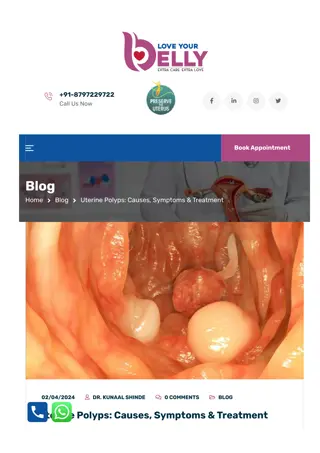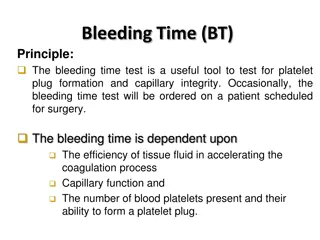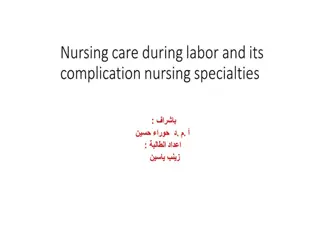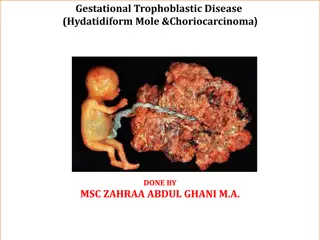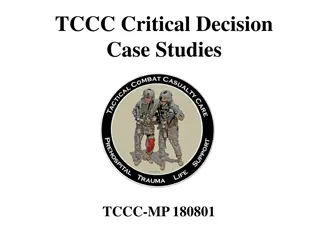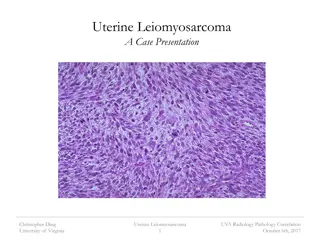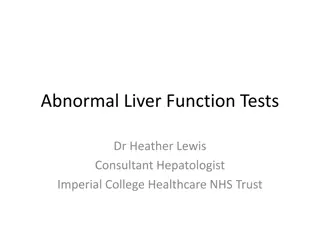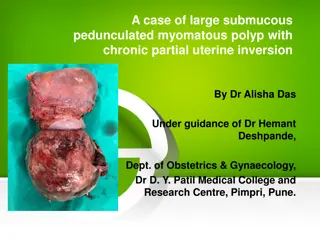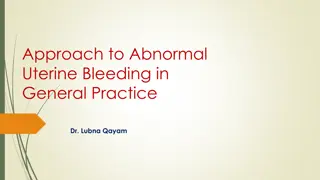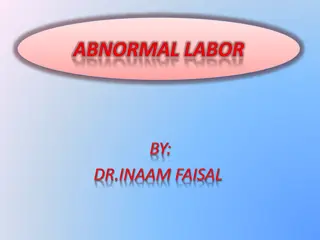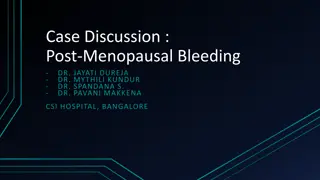Gynecological disorders
Common gynecological disorders including menstrual disorders and abnormal uterine bleeding. Find out about the nursing role in diagnosing and treating these disorders.
3 views • 22 slides
fibroids-and-fertility-what-you-need-to-know-
Worried about fibroids impacting your baby\u2019s dreams? Millions of women face the challenging reality of uterine fibroids. Female factor infertility can occur due to many reasons. It is highly important to regularly observe one\u2019s reproductive health. Many women of young age have issues relat
1 views • 6 slides
Uterine Fibroids-Symptoms Causes and Treatment
Are you suffering from Uterine fibroids? Looking for expert treatment, then you\u2019re at the right place. Dr. Shraddha Galgali is a leading & qualified gynecologist in Punwale, PCMC, Pune who specialize in treating various gynecological condition & surgery. On this page, She guides us on how to id
1 views • 6 slides
Gynecological Considerations for Long-Duration Spaceflight
This study by the National Aeronautics and Space Administration (NASA) discusses the potential effects of microgravity and space radiation on gynecological health during long-duration spaceflight. Topics covered include normal menstruation, fertility, gynecologic pathology, and the impact of hormona
0 views • 28 slides
Ticagrelor Monotherapy vs. 12-Month Dual Anti-Platelet Therapy After Coronary Stent Implantation for ACS
The study compares the efficacy of ticagrelor monotherapy after less than 1 month of dual anti-platelet therapy (DAPT) to 12-month ticagrelor-based DAPT in patients with acute coronary syndrome (ACS) undergoing percutaneous coronary intervention (PCI) with drug-eluting stent implantation. The aim is
1 views • 19 slides
Risks and Strategies for Safe Caesarean Deliveries in South Africa
Understanding the mortality burden related to caesarean deliveries (CD) in South Africa, this report highlights the need for safe CD practices amidst high maternal death rates. Factors influencing safe CD, checklists for accreditation, and strategies for action plans are discussed. The Case Fatality
0 views • 40 slides
Uterine Polyps Causes, Symptoms & Treatment
Despite frequently being benign, uterine endometrial polyps can have a serious influence on a woman\u2019s general health and her ability to conceive. These minute tissue developments in the uterine coating can cause a large number of side effects and results. Endometrial polyps, though usually non-
0 views • 8 slides
Understanding Bleeding Time and Coagulation Time Tests
The Bleeding Time (BT) test evaluates platelet plug formation and capillary integrity, crucial for surgery preparations. Prolonged bleeding times indicate low platelet count or dysfunction. The Duke method is one way to determine Bleeding Time. Sources of error, such as medication interference, impr
5 views • 8 slides
Understanding Heavy Menstrual Bleeding: A Comprehensive Overview
A detailed exploration of heavy menstrual bleeding (HMB) by Consultant Gynaecologist Mary Connor, highlighting its impact on women's health and well-being. The importance of early investigations, treatments, and referrals, as well as key considerations for women with obesity or estrogen imbalances.
4 views • 34 slides
Fibroids Treatment In Pune - Dr Shraddha Galgali
Are you suffering from uterine fibroids? Looking for expert treatment? Looking For Fibroids Treatment in Pune? You\u2019re at the right place.\nDr. Shraddha Galgali is a leading and qualified gynecologist in Punwale, PCMC, Pune, specializing in treating various gynecological conditions and performin
1 views • 7 slides
Placenta Accreta Syndrome: Definition, Risk Factors, Diagnosis, and Management
Placenta Accreta Syndrome (PAS) is characterized by abnormal placental implantation with firm adherence to the uterine muscle due to the absence of certain layers. Risk factors include previous cesarean section, placenta previa, advanced maternal age, and uterine anomalies. Diagnosis involves ultras
0 views • 16 slides
Understanding Blood Groups, Clotting Time, and Bleeding Time in Medical Practice
This informative material delves into the significance of determining blood groups, clotting time, and bleeding time in medical settings. From explaining the ABO and Rhesus systems to outlining the practical objectives and procedures for the assessments, this resource aims to enhance understanding o
0 views • 34 slides
Understanding Common Labor Complications and Management Options
Labor and birth processes are typically straightforward, but complications can arise, such as failure to progress, fetal distress, excessive bleeding, malposition, prolapsed umbilical cord, cephalopelvic disproportion, and uterine rupture. Management strategies include rupturing membranes, pain reli
1 views • 24 slides
Understanding Uterine Cancer and Postmenopausal Bleeding
Dr. Khalid Akkour, Assistant Professor of Gynecologic Oncology at King Saud University Medical City, provides insights on uterine cancer and postmenopausal bleeding. The structured OSCE discusses important aspects such as taking a focused history, age, ethnicity, past gynecologic and obstetric histo
0 views • 154 slides
Understanding Gestational Trophoblastic Disease: Hydatidiform Mole & Choriocarcinoma
Gestational trophoblastic disease encompasses hydatidiform mole, invasive mole, and choriocarcinoma. This condition involves abnormal fertilization of the oocyte, resulting in various presentations including abnormal growth of the uterus, severe nausea, vaginal bleeding, and symptoms resembling hype
1 views • 9 slides
TCCC Critical Decision Case Studies: Bleeding Management Scenario
This presentation focuses on a critical decision case study in Tactical Combat Casualty Care (TCCC) involving a casualty with high amputations and ongoing massive hemorrhage. The scenario explores the challenges of managing uncontrolled bleeding in a combat situation and provides insights into the r
0 views • 139 slides
Understanding Uterine Leiomyosarcoma: A Case Presentation
A 58-year-old female with a history of fibroids presented with post-menopausal bleeding and was diagnosed with uterine leiomyosarcoma, a rare and aggressive malignancy of uterine smooth muscle cells. The case details the clinical course, diagnosis, and prognosis of this condition, emphasizing the im
0 views • 17 slides
Bleeding Risk Estimation and New BARC Definition Overview
This presentation discusses the significance of bleeding as a clinical endpoint in the context of antithrombotic therapy, emphasizing the association between increased bleeding risk and adverse clinical outcomes. It explores hypothetical mechanisms linking bleeding events to mortality and the constr
1 views • 20 slides
Understanding Abnormal Liver Function Tests: Insights from Dr. Heather Lewis, Consultant Hepatologist
Abnormal liver function tests can be a perplexing issue with various underlying causes. Dr. Heather Lewis, a renowned Consultant Hepatologist at Imperial College Healthcare NHS Trust, sheds light on the significance of liver function tests, liver enzymes, and blood markers in diagnosing liver condit
0 views • 21 slides
Understanding Cancer: Causes, Symptoms, and Prevention
Cancer is a disease characterized by the uncontrollable growth and spread of abnormal cells in the body. These cells form tumors that can be either cancerous (malignant) or non-cancerous (benign). Cancer can develop in various parts of the body and is often caused by genetic changes that affect cell
3 views • 21 slides
Understanding Normal and Abnormal Behavior: Perspectives and Definitions
Normal behavior varies from person to person and society, influenced by individual preferences and societal norms. Abnormal behavior is characterized by an inability to function effectively or personal discomfort. The concept of normality and abnormality in psychology raises complex questions about
2 views • 8 slides
Understanding Subfertility: Causes, Diagnosis, and Management
Subfertility is defined as the failure to conceive after one year of regular, unprotected intercourse. Causes include ovulatory disorders, tubal factors, uterine factors, male factors, and unexplained factors. Diagnosis involves assessing ovulation, tubal patency, uterine abnormalities, and semen an
0 views • 20 slides
Understanding Endometrial Cancer: Risk Factors, Diagnosis, and Management
Endometrial cancer, the most common gynecological malignancy in women, presents with abnormal uterine bleeding and affects women mainly during menopause. Risk factors include hormonal stimulation and estrogen levels. Differentiating between types of endometrial cancer can impact treatment decisions.
3 views • 31 slides
Large Submucous Pedunculated Myomatous Polyp with Chronic Partial Uterine Inversion
A 41-year-old female presented with complaints of bleeding, foul-smelling discharge, abdominal pain, and a mass protruding from the vagina. History revealed menorrhagia, dysmenorrhea, and recent onset symptoms. Physical examination showed no significant abnormalities except for a firm palpable uteru
1 views • 19 slides
Understanding the Menstrual Cycle: Phases and Hormonal Regulation
Menstruation is a natural process where the uterine lining sheds accompanied by bleeding in monthly cycles. The menstrual cycle consists of three phases - Follicular, Ovulatory, and Luteal - regulated by hormones like estrogen and progesterone. This cycle starts with menstruation, followed by the re
0 views • 11 slides
Evaluation of Risk Stratification Schemes for Ischaemic Stroke and Bleeding in Atrial Fibrillation Patients
A study conducted in Sweden on 182,678 patients with atrial fibrillation aimed to investigate risk factors for stroke and bleeding. The research assessed the application of CHA2DS2-VASc and HAS-BLED schemes for stroke and bleeding risk evaluations. Data from the Swedish Atrial Fibrillation cohort st
0 views • 20 slides
Comparing Bleeding and Mortality Risks of Dabigatran vs. Rivaroxaban in Elderly Medicare Beneficiaries
A study by DJ Graham et al. compared the risks of stroke, bleeding, and mortality in elderly Medicare beneficiaries with nonvalvular atrial fibrillation treated with dabigatran or rivaroxaban. The study included over 118,000 patients and found that dabigatran was associated with a lower risk of majo
0 views • 9 slides
Understanding Pelvic Ultrasonography: A Comprehensive Guide
Explore the detailed anatomy and variations of the uterus, ovaries, fallopian tubes, and adnexa in pelvic ultrasonography. Learn about the different shapes and sizes of the uterus, layers of the uterine wall, and indications for pelvic ultrasound examination. Discover the significance of the appeara
1 views • 18 slides
Understanding Menstruation and Ovulation Cycle in Women
Menstruation, the cyclic uterine bleeding, is a result of hormonal interplay. It signifies ovarian events controlled by the hypothalamic-pituitary axis. The menstrual cycle, spanning from one period to the next, involves the release of ova and hormones like estrogen and progesterone. Menstruation ty
0 views • 49 slides
Cesarean Delivery Timing Guidelines for Women with Prior Uterine Scars
Society for Maternal Fetal Medicine provides cesarean delivery timing recommendations for women with prior uterine scars. For those with a history of classical cesarean, the risk of uterine rupture guides the timing of repeat cesarean. Similarly, women with prior myomectomy should plan delivery betw
0 views • 10 slides
Understanding the Physiology of Labor in Pregnancy
Labor, also known as parturition, is the process of uterine contractions leading to the expulsion of the fetus. Various hormonal changes, including increased estrogen levels, play a crucial role in triggering and regulating labor. The progression from a quiescent uterus to active contractions involv
0 views • 29 slides
Physiology of Labor: Onset and Key Hormonal Changes
Labor, or parturition, involves uterine contractions leading to the fetus's expulsion. Factors triggering labor include hormonal changes like increased estrogen and decreased progesterone, which stimulate uterine muscle activity. Telocytes play a role in spontaneous uterine activity, while oxytocin
0 views • 36 slides
Understanding Abnormal Psychology: Disorders, Symptoms, and Treatments
Explore the world of abnormal psychology through the lens of different disorders like depression, anxiety, and phobias. Learn about the definitions of abnormal behavior, DSM-V classifications, and various types of psychological disorders. Delve into the complexities of mental health conditions such
0 views • 39 slides
Comprehensive Guide to Abnormal Uterine Bleeding: Causes, Approach, and Management
Explore the approach to abnormal uterine bleeding in general practice with Dr. Lubna Qayam. Dive into different scenarios of patients presenting with varied symptoms and histories. Learn about the causes of abnormal uterine bleeding in reproductive age and post-menopausal women, including anovulator
0 views • 22 slides
Managing Abnormal Liver Function Tests in Primary Care: Summary Guideline
Guideline drafted by Dr. Sally Hull and Dr. Lucy Carter focuses on identifying patients at risk of chronic liver disease, increasing testing for treatable liver conditions, and auditing prevalence of major liver diseases. The importance of diagnosing Non-Alcoholic Fatty Liver Disease (NAFLD) and str
0 views • 23 slides
Understanding Uterine Displacement: Causes, Symptoms, and Treatment
Uterine displacement refers to the abnormal positioning of the uterus, such as retroversion and retroflexion. This article discusses the classification, etiology, diagnosis, and treatment of uterine displacements, focusing on retroverted uterus during pregnancy. Factors affecting uterine position an
0 views • 12 slides
Understanding Abnormal Labor and Prolonged Labor in Childbirth
Labor is considered abnormal when there is poor progress or signs of compromise in the fetus. Prolonged labor, lasting more than 18 hours, may result from various factors affecting cervical dilatation and descent of the presenting part. Causes include issues with power, passage, and passenger. Diagn
0 views • 20 slides
Case Discussion: Post-Menopausal Bleeding in a 65-year-old Woman
Mrs. Pauline, a 65-year-old woman presenting with post-menopausal bleeding for the past 4 months, without associated symptoms, history of recent weight changes, or hormonal therapy. Her menstrual and obstetric histories, along with past medical and surgical history, are significant. Further evaluati
0 views • 22 slides
Understanding Third Trimester Bleeding: Causes, Evaluation, and Management
Third trimester bleeding can be caused by various factors like placental abruption and previa, requiring prompt evaluation including assessing fetal heart rate and determining placental location. Different complications can arise for both the mother and fetus, necessitating specific management plans
0 views • 17 slides
First Aid for Controlling and Treating Bleeding and Injuries
Learn about how to handle and control bleeding, both internal and external, through first aid techniques including applying pressure bandages, using tourniquets, and recognizing signs of internal and external bleeding. Discover methods to assist victims and provide aid in various situations, such as
1 views • 18 slides


